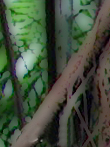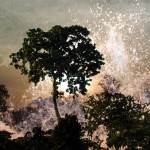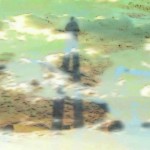Green Memories is based on the poetry of Persian author Forugh Farrokhzad and inspired by her poem ‘I PIty the Garden’
It is a 50 minute real-time visual music performance with vocals by Azam Ali, Violin by Keyavash Nourai, and Lila (a computer music instrument) by Shahrokh Yadegari. Animation, Photography, and Motion Painting by Vibeke Sorensen
Vibeke Sorensen interview with Julia Carnahan
Julia Carnahan: What was your impulse in creating this work?
Vibeke Sorensen: The need to see ourselves as intricately connected with nature and the earth, and not separate from it, and to encourage positive and peaceful engagement in saving the earth and its peoples. This requires sensitivity and respect for others, for life, across cultures and around the world. The recognition that a state of harmony within ourselves, is a result of living in harmony with nature, people and the world. Also that the opposite is true, that when we are out of balance with nature, we are out of harmony with ourselves. The scale of the imbalance and destruction of nature and humanity is now so great, so out of control, that the return path is not guaranteed. We are facing vast and dire ecological and human consequences to our collective human behavior, and we urgently need to address this. If we can bring forth through our work some recognition of our situation and potential, both positive and negative, and foster the responsible and ethical human interaction with the world, perhaps we may be able to help in some way to save it. To reconnect the body, mind, and nature.
Julia Carnahan: How has Forugh’s work inspired you? What does her poetry convey?
Vibeke Sorensen: Her poetry is to me a great window, perhaps a mirror, into the heart and mind of all mankind. She brings forth experiences, thoughts and feelings that make us more sensitive, more aware and more appreciative of life. She touches us, and evokes the most beautiful feelings inside us, reminding us that they are the very things that give our lives meaning, those that we will remember and cherish when we are old: the longings and joys and details of our days that arise from the condition of being alive — and what it really means to be human. To be able to see into the heart of a deeply aware, sensitive, and brilliant person sharing her existence with us is a gift of light to our lives. Both the joy and pain in her work touches me. I am inspired by her courage to transform it so beautifully into art. It helps us see that sadness and heartache can be overcome. Perhaps it is her strength and will to live that impresses me most – her natural and fluid intensity of desire to write, create and think. She imagines her freedom and frees her imagination, and reflects it so clearly that it helps us imagine a greater potential for other people and the world, for humanity.
(September 2005)
Julia Carnahan: Could you describe your media and process?
Vibeke Sorensen: About my process, it’s important to let people know that I am an artist and animator who works with a range of media to create a kind of ‘stream of consciousness,’ a continuously flowing river of visual thinking, one that is in constant transformation. I use real-time digital processes to set images and thinking free. I use non-deterministic processes so that associative and poetic structures can emerge in response to life, and in particular to live human experience and performance. So I work with a synthesis of documentary, painting, and animation, bringing the objective and subjective worlds into dialog with each other, and with us. In particular, in Green Memories, I recorded the images from around the world with digital photographic and digital video cameras, and edited and processed them with animation and image processing software. I then made this large database accessible to a real-time multimedia environment called Pure Data and Gem (see visualmusic.org) that allows me to access them (thousand of elements) in a wide range of ways, in real-time, and further transform them in response to the live performance.
(November 2005)



